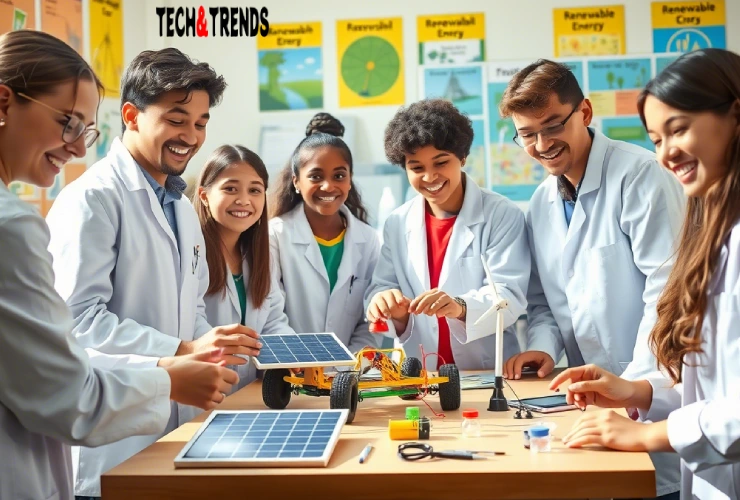Renewable energy is energy that comes from natural sources that do not run out, like the sun, wind, water, and even heat from the Earth. Learning about renewable energy is very important because it helps us protect the environment and reduce pollution. Best renewable ideas for students for science projects provide a fun and useful way to understand how these sources work and how they can be used in real life. For students, working on science projects about renewable energy is a great way to learn.
In this article, we will explore some of the best renewable ideas for students to use in their science projects. These ideas are simple, creative, and perfect for school projects. Let’s dive in!
1. Best Renewable Ideas for Students: In Science Projects to Try
There are many renewable energy ideas that students can try for their science projects. These projects help students learn about how energy can be made from natural sources and how it can be used to power things around us. Some easy projects include making a small solar panel, building a wind turbine model, or creating a water wheel to generate electricity.
Trying these projects helps students understand the science behind renewable energy and also encourages them to think about ways to save energy in their daily lives. These projects can be done with simple materials and do not require expensive tools.
2. Exploring Wind Energy in Student Science Projects
Wind energy is one of the most popular forms of renewable energy. It uses the power of the wind to create electricity. For a science project, students can build a small wind turbine model. This project shows how wind can turn blades, which then spin a small generator to produce electricity.
To build a wind turbine model, students need materials like cardboard, small motors, and plastic blades. They can test how different blade shapes and sizes affect the amount of electricity generated. This project teaches students about aerodynamics and energy conversion.
Wind energy is clean and does not produce pollution, making it a great topic for science projects that focus on protecting the environment.
3. How to Create a Simple Hydroelectric Model for Science Fairs
Hydroelectric power uses the energy of flowing water to generate electricity. For a simple science project, students can create a small hydroelectric generator using a water wheel and a small motor.
To make this project, students can use materials like plastic spoons for the water wheel blades, a small motor to act as the generator, and a container to hold water. When water flows over the blades, it makes the wheel spin, which turns the motor and produces electricity.
This project helps students understand how dams and rivers are used to create power in many parts of the world. It also shows the importance of water as a renewable energy source.
4. Using Biofuels in Student Science Experiments
Biofuels are fuels made from plants or animal waste. They are renewable because plants can be grown again and again. For a science project, students can explore how biofuels work by making simple biofuel from cooking oil or sugar.
One easy experiment is to create biodiesel from used cooking oil. Students can learn about the chemical process that turns oil into fuel. Another project is to test how different types of plant materials, like corn or sugarcane, produce ethanol, a type of biofuel.
These experiments teach students about chemistry and the importance of finding cleaner fuel alternatives to reduce pollution.
5. Best Renewable Ideas for Students: In Science Projects Using Solar Energy
Solar energy is energy from the sun. It is one of the most widely used renewable energy sources. Students can create many science projects using solar power, such as building a solar oven or a small solar-powered car.
A solar oven uses sunlight to cook food. Students can make one using cardboard, aluminum foil, and plastic wrap. This project shows how solar energy can be used in everyday life to save electricity and reduce pollution.
Another fun project is building a solar-powered car using small solar panels and motors. This helps students learn about electricity, solar cells, and how sunlight can be converted into power.
6. Building a Solar Oven: A Hands-On Science Project
A solar oven is a simple and effective way to use the sun’s energy for cooking. To build a solar oven, students need a cardboard box, aluminum foil, black paper, plastic wrap, and tape.
First, you line the inside of the box with black paper to absorb heat. Then, you cover the lid of the box with aluminum foil to reflect sunlight into the box. The plastic wrap covers the opening to keep heat inside.
When placed in the sun, the oven can get hot enough to cook small items like marshmallows or melt chocolate. This project teaches students about heat energy, insulation, and the power of the sun.
7. Investigating Geothermal Energy for School Projects
Geothermal energy comes from the heat inside the Earth. It is a clean and reliable source of energy used to heat buildings and generate electricity.
For a simple science project, students can explore how geothermal energy works by measuring temperature changes in soil at different depths. They can dig small holes and use thermometers to record temperatures and learn how heat from the Earth can be used.
Another idea is to build a model showing how geothermal power plants work, using diagrams and simple materials to explain the process.
This project helps students understand an important but less visible form of renewable energy.
8. Designing a Small-Scale Renewable Energy System
Students can challenge themselves by designing a small renewable energy system that combines different energy sources. For example, they can create a model house powered by solar panels and wind turbines.
This project involves planning, building, and testing. Students learn how to connect solar cells and small wind turbines to batteries and power small devices like LED lights.
Designing such a system teaches students about energy storage, electricity circuits, and how multiple renewable sources can work together to provide power.
9. Tips for Presenting Renewable Energy Science Projects Effectively
Presenting a science project well is just as important as doing the experiment. Here are some tips for students to present their renewable energy projects effectively:
- Use clear and simple language to explain your project.
- Include pictures and diagrams to show how your project works.
- Demonstrate your model if possible, to make it more interesting.
- Explain why renewable energy is important for the environment.
- Practice your presentation to speak confidently and answer questions.
Good presentation skills help students share their knowledge and inspire others to care about renewable energy.
Conclusion
Renewable energy is a fascinating topic that offers many opportunities for students to explore science in a fun and meaningful way. From building wind turbines and solar ovens to experimenting with biofuels and geothermal heat, these projects help students understand how clean energy works and why it is important for our planet.
By trying these best renewable ideas for students in science projects, young learners can develop skills in science, technology, and environmental awareness. These projects not only make learning enjoyable but also encourage students to think about solutions for a greener future.


Comments are closed.